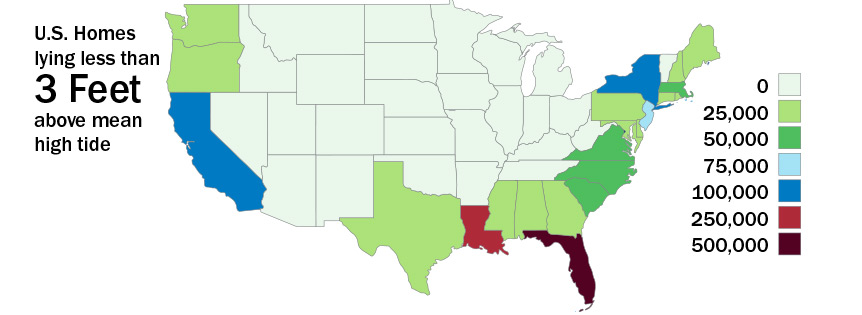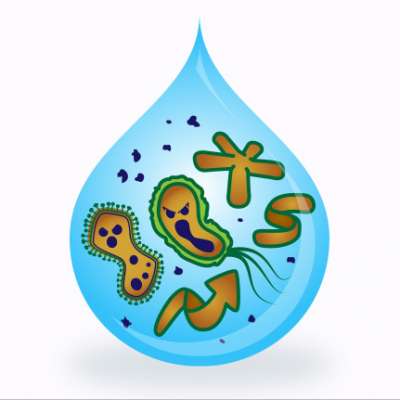The American public has certainly developed a love of the disaster film in recent years, and understandably so. Watching a hero run from crumbling terrafirma certainly gets the blood pumping from the safety of a theater seat. But as the earth’s temperature increases (hey, thanks global warming) and contributes to rising sea levels, the effects on the public aren’t quite as cinematic. The real world impacts of climate change are more gradual, but they still have devastating, and — dare I say — dramatic, far-reaching effects for water quality, all without a single life-or-death weather event.
For starters, coastal cities have more than just storm surge flooding to think about. Take Miami, capital of bright, fashionable summer retreats and attractive night life. A coastal city, much of Miami sits just above sea level, and while that might seem like the danger, it’s really what’s underneath the city that experts are concerned about.
Miami is built over a bedrock of porous limestone. So as ocean levels increase from melting glaciers, seawalls — much like those in other coastal cities like New York — won’t be able to hold Miami’s water at bay. Water can enter from underneath the city as it penetrates the air pockets in that limestone, and soon enough, the low-lying fresh water table.
And when those two bodies of water mingle, sea water could easily get into Miami’s supply of drinking water. Sure, it may not be The Day After Tomorrow dramatic, but that doesn’t mean it’s not a serious threat or have equally high stakes.
Cities Everywhere Need to Adapt, Not Just Coastal Cities
While the impact on coastal cities is concerning, for those further inland, it may seem easy to write off. But Americans would be wise to pay attention. As the earth’s climbing sea level will not only flood many coastal areas, it’ll also affect as much as 50 percent of fresh water supplies in coastal communities. Studies and simulations conducted by climate scientists have found that salt water can penetrate the water table underground, creating brackish water which dehydrates those who consume it.
Unfortunately, scientists have also discovered that depending on the sand texture of a given shoreline, mixed underground water can travel much further than it does above ground, potentially affecting the water quality of households up to 60 miles from a coast. In freshwater bodies where the ocean is increasingly encroaching — like California’s Sacramento-San Joaquin Delta, where the fresh water uptake for the Bay Area and Southern California comes from the same source — the threat of salinated water may travel even further.

So, what’s the big deal? It can just be desalinated, right? Well, in a word, yes. The relatively young city of Dubai, in the United Arab Emirates, is almost entirely without fresh water sources and has relied on large-scale reverse osmosis systems to desalinate water for residents.
Dubai’s desalination plant, Jebel Ali, creates 564 million gallons of freshwater a day by boiling seawater turning it to steam which passes through filters, leaving its salt behind.
As people around the globe look to solutions to a potential global water crisis, it’s possible this type of water filtration will become more prevalent, but keep in mind large scale plants such as Dubai’s are also expensive. And salt isn’t the only concerning item making its way into the water supply, and treatment systems will be looking at doing more than desalination to make the water potable.
That’s Not All, Folks — A Public Health Crisis
It’s old hat by now that climate change brings drought conditions, extreme downpours, and warmer overall water temperatures. Those heavier rains mean more water runoff and even flooding. In cities, that runoff can overwhelm sewage treatment facilities, pushing untreated sewage into the local water supply. Meanwhile, in rural areas excessive rain can push pesticides and animal waste into drinking water.
And that has scientists concerned for reasons beyond water pollution. A new study recently published in Scientific Reports looked at the consequences of more organic matter getting washed into freshwater supplies. (Thanks again, Hurricanes Harvey, Irene, Maria, et. al.) This water “browning” can make it tougher for the sun’s rays to penetrate water bodies past the surface. Why is that a big deal? Because the sun’s ultraviolet rays kill pathogens in water, in effect naturally disinfecting fresh water sources as part of the earth’s natural process.
With the powers of rising sea levels, increased pathogens combined, and less solar disinfection, we’re looking at Captaaaaaaaain Water Pollution. For those who might not remember this oh-so-clever reference to 90s kids’ show, Captain Planet, the subtext here is that these factors create prime conditions for bacteria and viruses to breed, spelling difficulties for public health.
Be Your Own Hero(ine)! What You Can Do
Reading all of this, it might be tempting to take off running into the night or create a traffic jam on the freeway trying to get to the nearest freshwater bunker (sorry to say: there’s no such thing). So let’s take a moment to catch our collective breath and stop hyperventilating. There are things people everywhere can do to mitigate the effects of the water crisis. Though it may seem to have little to do with water, many folks can start by walking and biking more and driving less and adding less CO2 (y’know, that villain warming our planet?) to the atmosphere. Reducing water consumption will help ease the burden in drought prone areas. Consider xeriscaping the yard instead of feeding that water-hungry grass — it’ll bring the one-two punch of both reducing water usage while also lowering bills.
That’s great for playing our small part in helping the wider world, but what about the water individuals come into contact with everyday?
People all over the world rely on safe drinking water for everything from brushing teeth and taking a shower to cooking to just the simple thirst quench and basic survival. Humans can’t live without clean water. So, start with your tap.
Research where your local water comes from and what impacts its upstream source. For those who don’t like what they find, consider a water filtration system or a tap water filter to sift out many contaminants. Lastly, contact your representatives (both local and national) and ask them to support policies that mitigate climate change.
Sure, all those solutions sound far less dramatic than being the disaster movie hero, but they’re easy ways everyone can help keep those scenarios out of real life and leave them where they belong: on the big screen.
